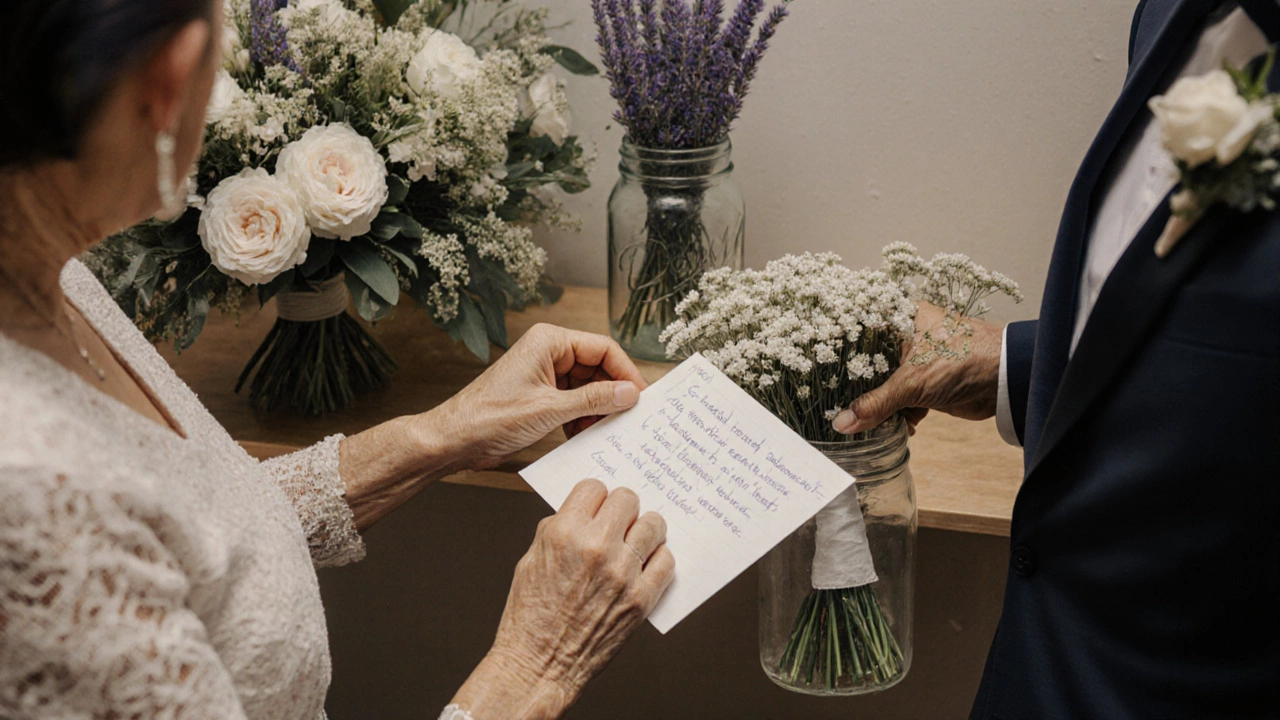Mother of the Groom Floral Etiquette Checker
Check Your Floral Choices
Use this checklist to ensure you're respecting the bride's vision and wedding traditions. Select all items you've done or plan to do.
Being the mother of the groom doesn’t mean you’re in charge of the flowers-but it does mean you’re part of the story they tell. Too many mothers of the groom end up causing quiet tension over blooms because they don’t know what not to do. It’s not about being controlling. It’s about respecting boundaries, timing, and the bride’s vision. Here’s what actually goes wrong-and how to avoid it.
Don’t pick flowers without consulting the bride
You love peonies. You’ve had them at every wedding you’ve ever attended. You think they’re romantic, classic, perfect. But the bride? She’s been dreaming of wild daisies and eucalyptus garlands since she was twelve. If you show up with a Pinterest board of peony centerpieces and hand it to the florist without asking, you’ve crossed a line. Wedding flowers are one of the bride’s most personal choices. They reflect her mood, her culture, her story. Even if you’re paying for them, it’s not your call. The bride’s floral vision isn’t a suggestion-it’s the blueprint.Don’t assume your son’s preferences are the same as the bride’s
Your son says he’s fine with anything. He doesn’t care if the flowers are white or pink. But that doesn’t mean the bride doesn’t care. You might think you’re helping by saying, “My son likes simple arrangements,” but that’s not the bride’s priority. She’s not choosing flowers for him. She’s choosing them for herself. Don’t translate his indifference into a design direction. Let the bride lead. If she wants bold red calla lilies, let her have them-even if your son thinks they look like fire hydrants.Don’t try to match your outfit to the flowers
You’ve spent weeks picking out your dress. You found the perfect shade of dusty rose. You’re thrilled. Then you see the bridal bouquet: ivory roses with greenery. You panic. You think, “Oh no, I need to change my dress so it matches.” Don’t. Your dress doesn’t need to coordinate with the flowers. It needs to coordinate with the wedding palette-and even then, only if the bride says so. Most brides don’t care what color you wear as long as it’s not white, ivory, or too flashy. Your job isn’t to blend in with the blooms. It’s to celebrate them.Don’t order extra flowers for your own table or family
You want a centerpiece for your table. Maybe even a small bouquet for yourself. You assume it’s fine-you’re family, right? But here’s the reality: wedding flowers are budgeted down to the last stem. Adding extra arrangements for your table, your sister’s table, or your husband’s cousins can blow the budget. Florists don’t charge by the hour-they charge by the design. One extra centerpiece might cost $150. Two might cost $400. That’s money taken from the bridal party’s bouquets or the ceremony arch. If you want something special, ask the bride first. If she says yes, offer to cover the cost yourself. Don’t assume it’s included.
Don’t criticize the florist in front of the bride
You’re at the floral preview. The arrangements look… different than you expected. Maybe the colors are too soft. Maybe the greenery is too wild. You say, “Hmm. I thought we were going for more traditional.” The bride hears it. She freezes. Her face tightens. You didn’t mean to hurt her-but you did. Florists work hard. They’re artists. They’ve spent hours listening to the bride’s dreams. If you have concerns, take them to your son. Let him talk to her. Don’t voice your opinion where it will be heard as a judgment. This isn’t about aesthetics-it’s about trust. The bride chose that florist because she felt seen. Don’t make her feel judged.Don’t show up with your own floral arrangements
You found a local flower market. You bought a bunch of lavender and arranged it in mason jars. You think it’s charming. You think it’s a sweet gesture. You bring it to the venue and set it on the guest book table. The bride sees it. She doesn’t say anything. But later, she tells her maid of honor, “I didn’t ask for that.” You didn’t ruin the day-but you made her feel like her vision wasn’t enough. Wedding flowers are curated. Every bloom has meaning. A random jar of lavender from the farmer’s market doesn’t belong unless it’s part of the plan. If you want to give a gift, give a gift card to the florist. Or a handwritten note. Not flowers.Don’t forget the groom’s buttonhole is not your project
You’re proud of your son. You want him to look perfect. So you call the florist and say, “Make sure his boutonniere matches the bride’s bouquet exactly.” You don’t realize that the groom’s buttonhole is usually designed to complement-not copy-the bride’s bouquet. It’s smaller. It’s simpler. It often uses one flower from the bridal bouquet as an accent. If you push for exact matching, you’ll end up with a bloated, mismatched look. The groom’s flower should be elegant, not overpowering. Let the florist do their job. If you want to help, offer to pay for an extra one for your husband. That’s thoughtful. Micromanaging the groom’s boutonniere? Not so much.
Don’t assume you know what’s traditional
You remember your wedding in 1987. Back then, mothers wore corsages. You think that’s still the rule. But today, many brides don’t even give corsages. Some give them to both mothers. Some give them to no one. Some give them to grandparents instead. Tradition isn’t set in stone-it’s a suggestion. And it’s not yours to enforce. If the bride wants to honor her stepmom with a flower but skip you, that’s her choice. Don’t make it about fairness. Don’t bring up your wedding. Don’t say, “In my day…” This isn’t about you. It’s about her.Don’t take over the flower delivery
You show up at the venue two hours early with your own car. You’ve got the flowers in the backseat. You’re going to make sure they’re placed perfectly. You’ve got the checklist. You’ve got the layout. You’re ready. But the bride’s team has already planned the delivery. The florist has a schedule. The venue has rules. You showing up with your own flowers? That’s not helpful. That’s a logistical nightmare. You’re not saving time-you’re creating chaos. Trust the professionals. Let the florist deliver. Let the wedding coordinator place them. Your job is to be there for your son. Not to run the floral department.Don’t ignore the cultural significance of flowers
The bride’s family is from the Philippines. They use sampaguita in wedding ceremonies. The bride wants it in her bouquet. You don’t know what it is. You think it’s just another white flower. You say, “Can we substitute it with gardenias? They’re more common.” That’s not just a floral choice-it’s a cultural one. Sampaguita means purity and devotion in Filipino tradition. It’s not about aesthetics. It’s about heritage. If you don’t understand a flower’s meaning, don’t suggest replacing it. Ask. Learn. Respect. The right flower can carry generations of meaning. Don’t let your ignorance erase it.Don’t forget: your role is support, not control
You love your son. You want his wedding to be perfect. That’s why you care. But the wedding isn’t yours. It’s theirs. The flowers aren’t your statement. They’re her expression. Your job isn’t to make sure everything looks like you’d want it. Your job is to stand beside your son, smile when he sees his bride walk down the aisle, and know that you helped make space for her joy. That’s the real legacy of the mother of the groom-not the flowers you picked, but the peace you gave her.Should the mother of the groom wear a corsage?
It’s entirely up to the bride. Some brides give corsages to both mothers, others only to the bride’s mother, and some skip them entirely. There’s no rule. If you’re unsure, ask the bride or the wedding planner. If you’d like one, offer to pay for it yourself to avoid pressure.
Can the mother of the groom help pay for the flowers?
Yes, but only if the bride and groom agree. Many couples split wedding costs differently-sometimes the groom’s family covers the rehearsal dinner, the bride’s covers the flowers. If you want to contribute, ask first. Don’t assume. And never insist on controlling how the money is spent. Your contribution should be a gift, not a condition.
What if I don’t like the flower colors the bride chose?
It’s okay to feel surprised. But it’s not okay to say so. Wedding colors are deeply personal. They might reflect the bride’s childhood, her heritage, or a meaningful date. If you’re struggling to accept them, talk to your son privately. Let him help you understand. Your opinion doesn’t override her vision. Your support does.
Is it okay to bring my own flowers to the ceremony?
No. Even if you mean well, unapproved flowers can disrupt the wedding’s flow, clash with the design, or violate venue rules. If you want to honor the couple, give a gift card to the florist or write a heartfelt letter. Flowers are part of a carefully planned visual story-don’t insert yourself into it.
What flowers are best for a groom’s buttonhole?
The groom’s buttonhole usually features one or two small blooms that echo the bridal bouquet-like a single rose, orchid, or spray of eucalyptus. It’s meant to be subtle, not match exactly. The florist will design it to complement, not copy. Avoid large or overly bright flowers-they’ll overpower the suit.

